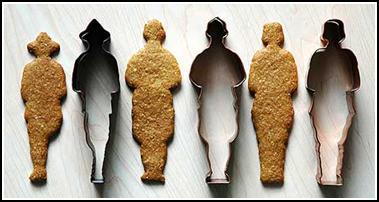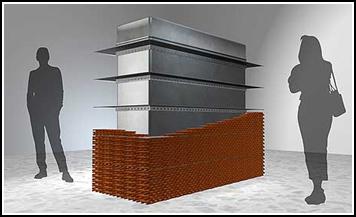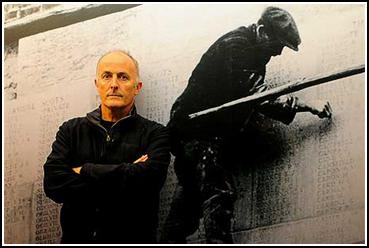Biscuit exhibit offers commentary on casualties of war
Tuesday, 15 April 2014, 3:15 pm
Press Release: Massey University

Examples of the Anzac biscuit cookie cutters.
Tuesday, April 15, 2014
Biscuit exhibit offers commentary on casualties of war
He has staged an art exhibition and installation of Anzac biscuits in France and now Associate Professor Kingsley Baird’s thought-provoking commentary on the carnage and casualties of war is to be staged in Germany – with some key differences.
Mr Baird, who is based at the School of Art on the Wellington campus, last year designed cookie cutters in the shape of able-bodied and maimed soldiers from World War I. The differently shaped cookie cutters-depicting Australian, New Zealand, French and German soldiers will be used to cut out specially baked Anzac biscuits which will then be exhibited around a biscuit tin-shaped ‘cenotaph’ at the Militarhistorisches Museum der Bundeswehr in Dresden, Germany beginning in June. Mr Baird’s essay on the exhibit will also be enclosed in the museum’s World War I exhibition catalogue.
The stainless steel cenotaph (built by German metal craftsmen) will replicate the idea of bodies of many German soldiers buried on top of one another as is common in German war cemeteries while the biscuits, sitting on shelves attached to the outside of the cenotaph and able to be eaten by museum visitors, convey a separate commentary on the shared carnage and loss wrought in Europe almost a century ago, Mr Baird says.
Advertisement - scroll to continue reading

A concept image by School of Design senior lecturer Gray Hodgkinson of the Stela cenotaph partly covered by Anzac biscuits
“It’s analogous of the consumption of the soldiers in battle and the responsibility citizens have when allowing soldiers to be sent to war and maybe to die. It also contrasts the solidity of the cenotaph with the fragility and impermanence of the biscuits that represent the soldiers,” he says.
“This is a comment on the ephemeral nature of memory and our representation of it in the permanent materials of memorials.”
A pattern of oak leaves, the traditional German symbol of remembrance, may also be used to decorate the exterior of the work called Stela.
Last year in France Mr Baird created the installation Tomb a sculpture based on the Stone of Remembrance designed by Sir Edwin Lutyens and found in Commonwealth War cemeteries.
His latest exhibition also harks back to the characteristics of remembrance as depicted through cemeteries – on this occasion acknowledging German modes of remembering the war dead.

Associate Professor Kingsley Baird
“There is a collective remembrance of the fallen in Commonwealth war graves yet each soldier has his or her individual gravestone. German collective expression is represented by the fact soldiers are buried side by side or on top of each other in mass graves as a gesture of comradeship.”
It continues a rich catalogue by Mr Baird of memorials honouring the war dead. In 2004 he designed the Tomb of the Unknown Warrior in Wellington and three years earlier the New Zealand Memorial in Canberra with Wellington architectural firm Studio of Pacific Architecture.
Advertisement - scroll to continue reading
a.supporter:hover {background:#EC4438!important;} @media screen and (max-width: 480px) { #byline-block div.byline-block {padding-right:16px;}}
Using Scoop for work?
Scoop is free for personal use, but you’ll need a licence for work use. This is part of our Ethical Paywall and how we fund Scoop. Join today with plans starting from less than $3 per week, plus gain access to exclusive Pro features.
Join Pro Individual Find out more
Find more from Massey University on InfoPages.